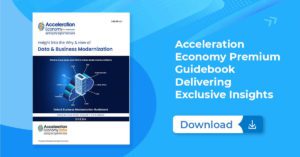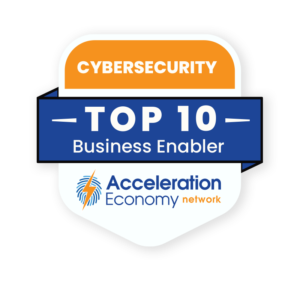In today’s fast-paced business world, data is an invaluable asset, and a CIO can play a critical role in driving profitability and improving security for their company by leveraging data and analytics to identify cost-saving opportunities, optimize IT investment, and, ultimately, increase profitability.
Additionally, a data-driven approach to security can help protect critical data assets and reduce the risk of data breaches or other security incidents. From my experience migrating, managing, and leveraging data as a manufacturing CIO, I’m going to share ideas on how a data-driven CIO can deliver value in these vital areas. I’ll also present best practices I’ve learned for making the most of data and analytics to achieve business success.
Which companies are the most important vendors in data? Click here to see the Acceleration Economy Top 10 Data Modernization Short List, as selected by our expert team of practitioner-analysts
Driving Profitability With Data
As a data-driven CIO, you can help your company increase profitability by leveraging data and analytics. By analyzing data on business operations and technology usage, you can identify areas where the company can reduce costs, directly affecting the bottom line. Here are three examples of how you can apply data for business results:
- Cloud Migration: Move applications and data to the cloud to reduce capital expenses on hardware and software, as well as operational expenses on maintenance and upgrades. Cloud migration can help your company scale up or down more easily, which aids in reducing costs during periods of reduced demand (something we have all experienced over the past three years). Utilizing multiple cloud providers can also help control costs if you have a platform that gives you comparative cost data when moving resources from one cloud provider to another. When my team migrated our ERP from Dynamics AX 2012 on-premises to cloud-based Dynamics 365 F&O, it significantly changed the way we spend money on that system. Cloud subscriptions, rather than capital expenditures, are now the focus.
- IT Process Automation: Automate routine IT tasks, such as software updates, backups, and system maintenance to reduce labor costs and improve productivity. IT process automation can also help to reduce errors and improve overall system reliability, which can further reduce costs.
- Software License Management: Identify and eliminate unused or underutilized licenses to reduce software expenses and improve overall license compliance. Effective license management can also help your company avoid costly penalties for non-compliance, which can further reduce costs. For our company, we have had to pay particularly close attention to Microsoft licensing. In Dynamics 365, for instance, some licenses range from $10/month to $200+/month, depending on which security roles a given user needs. And Azure licensing for virtual machines and other services can also range widely, depending on exactly what you need. A failure to examine license costs can prove quite expensive.
By focusing on these and other areas, you can help your company reduce costs and improve its overall financial performance. Here’s a three-step process to get started driving costs down:
- Conduct a Cost Analysis: Gather data on the company’s IT spending, including hardware, software, and maintenance expenses. Identify areas where the company is spending more than it needs to, and where it can reduce costs without sacrificing performance. My team and I revisit our various costs, including hardware, licenses, and communications, at least once a year to see where the majority of the expenses are coming from and ensure that we are still getting the best value for the spend.
- Prioritize Cost-Reduction Opportunities: Rank cost-reduction opportunities based on their potential impact and feasibility. Consider factors such as the cost of implementation, the complexity of the initiative, and the potential impact on the company’s operations.
- Develop and Implement a Cost-Reduction Plan: This plan should include specific initiatives and action steps, timelines, and resource allocations. Work with other business leaders to ensure the plan is aligned with the company’s overall strategic goals and objectives. Regularly monitor and adjust the plan as needed to ensure that it is achieving its intended results.
Enhancing Security With Data
As a data-driven CIO, you can help your company improve security by using data and analytics to identify which assets are critical and directing security efforts to those assets. By providing real-time data on security threats and vulnerabilities, you can help business leaders make informed decisions about risk management and allocate resources where they are needed most.
Many data assets might be prioritized for risk analysis and higher security focus, depending on your industry and the specific needs of your company. Here are a few examples:
- Customer data: This may include personal information such as names, addresses, social security numbers, credit card numbers, and other sensitive data that could be used for identity theft or fraud.
- Financial data: Revenue, profit and loss statements, and cash flow reports are sensitive and valuable assets that need to be protected from unauthorized access, theft, or manipulation.
- Intellectual property: Trade secrets, patents, and proprietary technology are critical assets that need to be protected from theft or unauthorized access. In the manufacturing industry that I work in, this is one of the most important areas to understand and protect, but also one of the easiest to overlook.
- Employee data: Personal information, payroll data, and health records need to be protected from unauthorized access and misuse.
- Operational data: Manufacturing processes, supply chain information, and logistics data are critical assets that need to be protected from theft, sabotage, and manipulation. You may remember a major data breach that Target suffered several years ago. In that case, hackers gained access via a refrigeration and HVAC provider.
By identifying and prioritizing protection of these data assets, a data-driven CIO can develop a targeted security strategy that focuses on the most critical assets and mitigates risk to the company. Here’s a three-step process for identifying critical data assets and establishing a plan to protect them:
- Identify and Classify Data Assets: Work with key stakeholders across the company, such as legal, compliance, finance, and IT, to identify and document all data assets that your company owns, processes, or stores. Classify these assets based on their sensitivity, value, and potential impact on the business. This classification will help to prioritize which assets require the most protection and guide the development of security policies and controls.
- Conduct a Risk Assessment: Identify potential threats and vulnerabilities that could impact the security and integrity of these assets. Include a review of the potential impact and likelihood of threats, as well as the current security controls in place. When we embarked on strengthening our cybersecurity posture at my company, we began with a risk assessment. It was important for us to know what potential risks existed before we could start putting a framework in place to protect the company.
- Develop and Implement Security Policies and Controls: Address the risks identified in the risk assessment. Implement access controls, encryption, data loss prevention measures, and other security measures to protect critical data assets. Regularly test and monitor these controls to ensure they are effective in protecting the company’s data assets. You should also establish ongoing training and awareness programs to educate employees on the importance of data security and the role they play in protecting critical data assets. When we built the security policies and controls for my company, I soon realized that I wanted to understand more about how hackers operated. I took a course and earned a certificate called Certified Ethical Hacker. It helped me gain a better understanding of the controls needed, and how to monitor them effectively.
Conclusion
As a data-driven CIO, you can bring tremendous value to your company by leveraging data and analytics to drive profitability and improve security. By identifying cost-saving opportunities and optimizing IT spending, you can help your company achieve better financial performance. And by prioritizing critical data assets and implementing security policies and controls, you can help reduce the risk of data breaches and other security incidents.
Want more tech insights for the top execs? Visit the Leadership channel:












